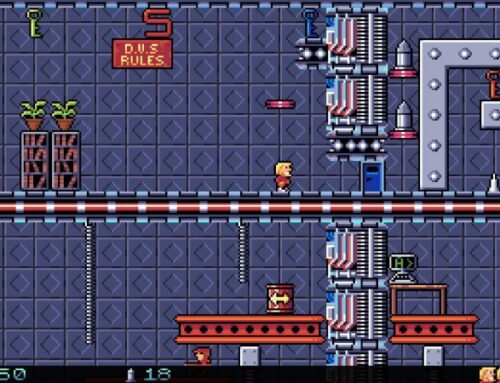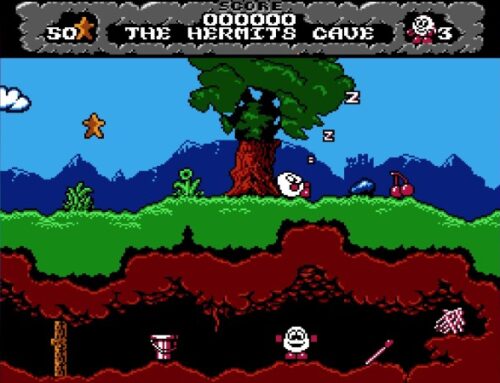There’s a dearth of good Intellivision writing on the Internet — so we’re doing our bit to put that right by working our way through the library of fascinating games for this unusual system!
Cloudy Mountain — known variously as Advanced Dungeons & Dragons Cartridge (yes, the word “cartridge” was actually part of its title at one point), Advanced Dungeons & Dragons: Cloudy Mountain, Adventure and simply Cloudy Mountain — is an excellent and somewhat noteworthy entry in the Intellivision’s library of games.
Not only was it one of the earliest officially licensed Dungeons & Dragons games — despite the actual gameplay having very little to do with the tabletop Dungeons & Dragons ruleset — it was also the first Intellivision cartridge to push the boundaries by being on a cartridge with more than 4 kilobytes of ROM. That, of course, might sound laughable to a modern gamer, but in 1982 that was a big deal.

And it’s not hard to see where that humongous cartridge capacity went. Cloudy Mountain (as we shall refer to it hereafter) is an impressively large, complex game for the time, featuring multiple layers of gameplay, decent visuals and a varied, challenging quest for players to complete.
In Cloudy Mountain, you take on the role of an adventuring party tasked with retrieving the two halves of the Crown of Kings. No further explanation is given for your quest: you just, apparently, really need the Crown of Kings and, rather inconveniently, both of its pieces are buried deep in the caverns beneath Cloudy Mountain and guarded by winged dragons.
There are two main components to Cloudy Mountain: the strategy map and cave exploration.
On the strategy map, you’re given an overview of the world in which your quest unfolds; for added replay value, this is randomised each time you play. You start in a little hut on the western edge of the map; Cloudy Mountain, meanwhile, appears on the far right, with its colour indicating which of the game’s four difficulty levels you’re playing on.

Between you and Cloudy Mountain are a variety of obstacles, including mountain ranges, rivers, forests, walls and gates. In order to successfully pass across the map, you’ll need to delve into the caves inside those mountain ranges, retrieve a boat, axe and key to deal with rivers, forests and gates respectively, and finally leap headlong into the dangerous dungeons beneath Cloudy Mountain in search of your final goal.
Curiously, movement on the map in Cloudy Mountain is accomplished not using the Intellivision’s directional disc controller, but rather using the telephone-style keypad. Each tap of one of the 1-9 buttons moves you in the corresponding direction — including diagonally — and a press of the zero key emits a “clicking” noise, with the number of clicks indicating how many arrows you have left in your quiver. Regardless of difficulty, you start with just three arrows — which feels woefully unprepared for an apparently epic quest — but you can acquire more as you progress.
Your main priority in Cloudy Mountain will be investigating the mountain ranges. Brown-coloured mountains are always impassable, but black mountains contain cave systems that you can explore and pass through. By moving your party adjacent to one of these black mountains, it will change colour, and the different colours indicate not only the relative difficulty of the dungeon within, but also the treasure you might be able to find down there.

Grey mountains are easy dungeons, and provide nothing more than additions to your stocks of arrows. Blue mountains contain the boat and additional arrows, and are a little harder. Red mountains are harder still, and allow you the opportunity to pick up the axe and some more arrows. And purple mountains are the most difficult aside from Cloudy Mountain itself, but can potentially reward you with the key to open gates and yet more arrows.
Once inside a cave, you enter a randomly generated scrolling dungeon covered by a fog of war, and thus you’ll need to explore in order to uncover the map and discover what lies within. Each cave has a map that wraps around on itself, and there are two possible sizes of dungeon: one is eight rooms wide and four rooms high, while the smaller variant is four rooms wide in both directions.
In a cave, the control scheme changes: now you can move your character with the Intellivision’s disc controller, and the keypad instead allows you to fire arrows in any of 8 directions. This isn’t a “twin stick shooter” of sorts, however; arrows ricochet off walls (right back into your face if you fire them at a straight-on angle) and follow passageways, so it’s possible to fire around corners and defeat monsters before they’re even aware of your presence if you’re skilled enough.

On the easiest difficulty, you can generally get away with dealing with monsters reflexively — that is to say, they move slowly enough that you can put enough distance between you and them to fire off an arrow or two and avoid injury. On harder levels, though, the monsters move more quickly and become much more ferocious, and it’s here that Cloudy Mountain is at its most interesting — and perhaps most overly ambitious.
Each monster behaves in a particular way, and there are various ways of determining a particular monster is present in a dungeon before you even see them. Sometimes you might see tracks on the ground; at others you might see discarded bones, or even hear a distant growling. By making good use of these various means of “tracking” monsters, you can prepare yourself accordingly and shoot an arrow up their arse before they even see you — or perhaps simply plot a suitable route around them. Those arrows are a finite, precious resource, after all!
Defeating a monster provides you with no real benefit other than making the dungeon a bit safer; there’s no experience or progression system in Cloudy Mountain and, indeed, as previously noted, the game’s mechanics bear absolutely zero resemblance to tabletop D&D. This is a tactical action game through and through, and should be played accordingly; there’s no need to “grind” because there is literally nothing to “grind” — beating the game is therefore simply a case of locating the various key items to progress across the map, then clearing the Cloudy Mountain dungeon.

It might sound simplistic, and compared to modern RPG quests — or indeed, early attempts at RPGs on home computers that were showing up around this time, such as Epyx’s Dunjonquest series — it absolutely is simple. But in many ways, that is part of the attraction of Cloudy Mountain. It’s straightforward, it’s clear, its rules are easy to understand and your goal is obvious. Moreover, it’s designed to be beaten in a single sitting — at least partly because the Intellivision offered no game-saving facility — and replayed endlessly thanks to its randomised elements and varied difficulty levels.
Replay value could have perhaps been enhanced somewhat with some sort of scoring system — maybe with the addition of some optional treasures to gather while exploring the dungeons? — but as it stands, Cloudy Mountain is still a good time, and well worth a playthrough or two. Just make sure you map your controls carefully if you’re playing on a modern emulator, because you’re going to need pretty much every one of those buttons!
As with most Intellivision games, there’s some interesting insights to be found about Cloudy Mountain over on the Blue Sky Rangers’ website!





